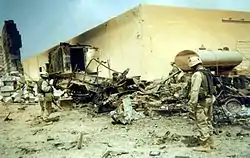Al-Samoud 2
Al-Samoud (الصمود, alternately Al-Samed, which means steadfastness in Arabic)[2] was a liquid-propellant rocket tactical ballistic missile developed by Iraq in the years between the Gulf War and the 2003 Invasion of Iraq. The Iraqi army also developed a solid-fuel rocket version known as Ababil-100.
| Al Samoud | |
|---|---|
 An Al Samoud missile captured by US forces in Southern Iraq (2003) | |
| Type | Single-stage ballistic missile |
| Service history | |
| In service | 2003 |
| Used by | Iraqi Army |
| Production history | |
| Manufacturer | Iraq |
| Produced | 2001-2003 |
| Specifications | |
| Length | 7,14m |
| Diameter | 760mm |
| Warhead | 280kg |
| Propellant | Liquid propellant (Al-Samoud)RFNA/UDMH[1] Solid propellant (Ababil-100) |
Operational range | 180km |
Guidance system | Inertial |
| Accuracy | 2.0 km CEP[1] |
Launch platform | Mobile launcher |
Development
The missile was essentially a scaled-down Scud, though parts were mostly derived from the Soviet S-75 Dvina surface-to-air missile. The first test-firing was carried out as early as 1997[2] and was supervised by UNSCOM.[3] The production started in 2001, and the goal was the assembly of ten missiles each month. The Al Samoud 2 was not fully operational by 2003, but some of them had been already delivered to the Iraqi army.
Engine
The rocket engine evolved from the S-75 Dvina design and the thrust vector controls from the Scud. The system also included an Iraqi-designed mobile launcher similar to the Al-Nida, built for the missile Al Hussein,[4] produced by the Iraqi company Al-Fida.[5]
Payload
The missile carried a 280 kilogram warhead that was half high explosives and half protective steel shell. The explosive charge weighed 140 kg, made of a mixture of 84 kg of RDX=60%, 42 kg of TNT= 30% and 14 kg of aluminium= 10%, the latter used as an energetic blast enhancer. The payload was also designed to upload different types of bomblets.
Guidance
The guidance package was assembled by cannibalizing gyroscopes from the Chinese Silkworm cruise missile. A source is cited as claiming that there were inertial and even GPS guidance systems illegally imported from Belarus, but these allegations have not been confirmed.
Banned by the UN

On February 13, 2003, a UN panel reported that Iraq's Al-Samoud 2 missiles, disclosed by Iraq to weapons inspectors in December, have a range of 180 km, in breach of UNSCR 1441. The limit allowed by the UN is 150 km.
Iraq agreed to destroy the Al-Samoud 2 long range missiles, and by mid-March 2003, a number had been destroyed. Although UNMOVIC ordered to stop its production, Iraq assembled some 20 missiles during the early months of 2003.
American forces found a cache of 12 Al Samoud missiles south of Baiji on July 21, 2003.
Operational history (March–April 2003)

A number of Al-Samoud 2 missiles were fired at Kuwait during the 2003 conflict.[6] One of them, aimed at the Coalition Headquarters at Camp Doha, was successfully intercepted by a Patriot missile on March 27. Some debris hit buildings inside the US base.[7] The other missiles were also shot down or landed harmlessly in the desert.
A similar development, the Al-Fahd or Ababil-100, a solid propellant version of the Al-Samoud, was also used by the Iraqi army during the invasion. The Headquarters of the 2nd Brigade, US 3rd Infantry Division, were struck south of Baghdad by a missile of this kind on April 7. Three soldiers and two foreign reporters were killed in the blast.[8][9][10][11][12]
References
- "GIS SPecial Topical Studies:Iraq war 2003". ISSA Special Reports. Archived from the original on 17 March 2017.
- Miller, David: Conflict Iraq: Weapons and tactics of US and Iraqi Forces. Zenith imprint, 2003, page 22. ISBN 0-7603-1592-2
- Iraq's missile programs Archived 2015-02-18 at the Wayback Machine
- Cordesman, Anthony (2003). The Great Iraqi Missile Mystery: The Military Importance of the Ababil, Al Samoud II, Al Fatah, Badr 2000, and Al Huysayn Archived 2010-02-09 at the Wayback Machine. Center for Strategic and International Studies, 25 February 2003
- Unmovic - IAEA Press Statement on Inspection Activities in Iraq, 19 February 2003
- The sources claim that only three to five Al-Samoud 2 were actually used by the Iraqis, the remainder missiles were purportedly Ababil-100/Al-Fahd or Laith-90, this latter a locally upgraded version of the Frog-7:
- www.cdi.org Archived 2003-12-23 at the Wayback Machine
- www.cnn.com/2003
- Zucchino, David: Thunder Run: The Armored Strike to Capture Baghdad. Grove Press, 2004, page 162.
- "He (Lt. Col. Wesley, second in command) had gotten only thirty feet from his vehicle when a powerful Abril (sic) missile hit it dead center." Lacey, Jim:Takedown: the 3rd Infantry Division's twenty-one day assault on Baghdad. Naval Institute Press, 2007, page 243. ISBN 1-59114-458-2
- Iraqi missile hits Army base, By Steven Lee Myers. The New York Times, 04/07/2003.
- Nach ersten Erkenntnissen soll es sich um eine irakische Boden-Boden-Rakete vom Typ Ababil-100 mit einer Reichweite von 130 Kilometern handeln. Focus magazine, 14 April 2003, report by Gudrun Dometeit (in German)
- Perry, Walter L. (2015). Operation Iraqi Freedom: Decisive War, Elusive Peace (PDF). RAND Corporation. p. 178. ISBN 978-0-8330-4192-0.
